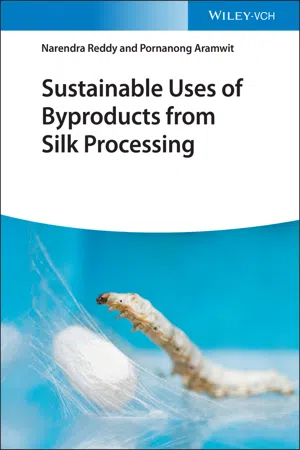
- English
- ePUB (mobile friendly)
- Available on iOS & Android
Sustainable Uses of Byproducts from Silk Processing
About this book
Explore this authoritative guide to transforming the silk industry written by two experts in biopolymers and materials science
Sustainable Uses of Byproducts from Silk Processing delivers a detailed treatment of the properties and potential applications of silk sources, by-products, and waste. The book describes the composition, structure, processability, and potential applications of all of the different kinds of silk by-products. Highly relevant to those working in mulberry cultivation, silkworm rearing, and silk processing, the distinguished authors offer information on how to transform silk by-products into new materials, energy, fuel, fibers, composites, food, cosmetics, and feed.
Using a valorisation approach to the silk protein sericin and its by-products and taking an application-oriented view of materials sources and wastes in the silk industry. Implementation of these techniques promises to further industries as diverse as cancer treatment, pharmaceuticals, nutraceuticals, and environmental cleanup.
Readers will also benefit from the inclusion of:
- A thorough introduction to sericin, including its structure and properties, how to process it, and its various applications
- An exploration of mulberry leaves, stems, and fruits, including their composition and properties, processing, and non-feed applications
- Discussions of the various uses of silkworm pupae, including food and feed, pupae oil properties and applications, biodiesel, byproducts of biodiesel, and the extraction of chitin and proteins from the pupae shell
- An examination of the applications of silkworm litter
Perfect for protein chemists, biotechnologists, cosmetics industry professionals, and materials scientists, Sustainable Uses of Byproducts from Silk Processing will also earn a place in the libraries of polymer and cosmetic chemists who seek a one-stop reference for current and emerging sustainability practices in the silk industry.
Frequently asked questions
- Essential is ideal for learners and professionals who enjoy exploring a wide range of subjects. Access the Essential Library with 800,000+ trusted titles and best-sellers across business, personal growth, and the humanities. Includes unlimited reading time and Standard Read Aloud voice.
- Complete: Perfect for advanced learners and researchers needing full, unrestricted access. Unlock 1.4M+ books across hundreds of subjects, including academic and specialized titles. The Complete Plan also includes advanced features like Premium Read Aloud and Research Assistant.
Please note we cannot support devices running on iOS 13 and Android 7 or earlier. Learn more about using the app.
Information
1
Sericin: Structure and Properties
1.1 Type of Silk Sericin
1.2 Localization of Silk Sericin

1.3 Molecular Mass of Sericin
1.3.1 Middle Silk Gland Sericin
Table of contents
- Cover
- Table of Contents
- Title Page
- Copyright
- Preface
- 1 Sericin: Structure and Properties
- 2 Processing Sericin
- 3 Applications of Sericin
- 4 Non‐silk Applications of Mulberry Plants
- 5 Pupae and Its Applications
- 6 Applications of Pupae Litter (excrement)
- 7 Converting Silk Wastes into Composites, Energy Storage Devices, and Other Value‐Added Materials
- Glossary
- Index
- End User License Agreement